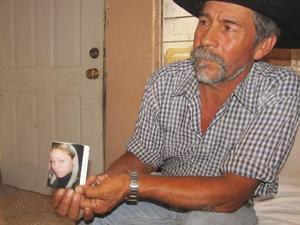The disappearance of women in Apodaca, Nuevo León has become a routine occurrence since the Zetas took over one of the fastest-growing and most marginalized counties in the state. Some of the women were kidnapped off the street or chosen at random for their appearance. Others were taken from their houses at gunpoint and by threats. The rest didn't return from work, from parties, or from a nightclub. All share the common traits of being poor, young, and pretty.
In the streets of the Los Fresnos, Nuevo Amanecer, and Jardínes de los Pinos neighborhoods, shootouts have become daily happenings. First, the Zetas came selling drugs. Then, the municipal government abandoned their security posts. Finally, the turf quota payoffs, the murders, and the indiscriminate robberies transformed the area into a hot spot.
New customized cars seem normal in the streets packed with little social housing projects. New luxury trucks make their rounds. Last Wednesday, bullets sent a group of police detectives from the anti-kidnapping unit packing. Gunmen aboard a number of stolen taxis took the initiative to remind them that this territory is a nest of the Zetas.

In a house in the immense Nuevo Amanecer residential complex, a group of parents has decided to meet for the first time since their daughters disappeared months ago. All admit to feeling wary about attending the meeting with La Jornada. They accept that some of their daughters were hanging with the wrong crowd, but recognize that they haven't filed formal complaints due to their lack of trust in the authorities. “The polizetas make fun of us when we go to inquire about our daughters," says one of the mothers, referring to Apodaca's public security forces [which they say are infiltrated by the Zeta drug cartel].
Teodora Reyes Meza (53) hands out a slip of paper with a prayer and a photo of her daughter on it. Azalea Magdiel Alonso Reyes, like the other young women, was deprived of her freedom. “Today she would be celebrating her 19th birthday . . . I ask for your support in this prayer for her and the other young ladies; although we don't know the conditions in which they are living, we ask the heavenly father for a miracle, for a sign, so that we know something about them," states the text.
Dozens of women have disappeared since the start of the Mexican war on the narcotraffickers. The drug cartels have diversified their criminal activity.
The Attorney General's office of Nuevo León has no statistics on the crime of human trafficking of women, although the state is considered a hub for the distribution of women for sexual exploitation to the rest of the country—a trade that involves criminals, politicians, officials, police, and businessmen.
"In Apodaca alone, in less than two years we have counted more than 105 young women who have been kidnapped," says Martha Alicia Quintanilla Ibarra, mother of 22-year-old Lizette Alicia Mireles, who has been missing since December 2nd after leaving her job at a casino.
Without a Trace
Azalea is slender, tan, and has slightly slanted eyes. Very pretty. A photo of her as a 15-year-old is in the living room. Teodora welcomes everyone. She lost her sight and her already poor health has deteriorated since her daughter disappeared February 15, 2010. “Some men came for her. They called her first on the telephone. Then one got out of a car and knocked very hard on the door, yelling. All she said was 'Mommy, I'll be right back.'"
Ransoms were not requested for any of the missing young women. Some spoke with their parents after being kidnapped to ask that they neither look for them nor file missing person reports with the police. Ten of them were friends or acquaintances, and they were kidnapped within the same week.
The day after Azalea's kidnapping, 18-year-old Cecilia Abigaíl Chávez Torres disappeared. She was seven months pregnant. “A friend, who I believe was already kidnapped, was the lure. She called several times and invited them to a party. They never came back. My daughter called me four days after she went missing and told me: 'Mom, don't worry, I'm fine' and hung up. She never called back," says 45-year-old Cecilia Torres Morales.
She says her daughter worked as a product promoter at Delta Transformers and became involved with Juan Francisco Zapata Gallegos, a.k.a. "Billy Sierra" or "El Pelón," the Zeta boss of Monterrey who was arrested in August, 2010.
“He's the child's father. I never met him. She told me El Pelón didn't tell her he was a hitman. He confessed when she was four months pregnant. I told her, 'you got yourself into this problem and we'll see how you'll work it out, but don't bring him here.' I have other kids. Imagine if I had let him come into my house—we wouldn't be alive now. When they arrested him, I saw it in the newspaper. He knows where my daughter is and I want him to tell me or the Siedo [The Attorney General's Special Investigative Office on Organized Crime]. They have him in custody in Mexico City."
Cecilia is convinced her daughter is a victim of human trafficking. Statistics from the U.S. Department of State affirm that each year in Mexico, more than 20,000 people are kidnapped in relation to the crime.
"They can be forced into prostitution or drug smuggling. These young women are part of their business. They generate a lot of money. It's clear they have a network of girls. It's sex trafficking," she notes, adding that she never reported the disappearance of Cecilia Abigaíl to the police for fear and a lack of trust. "They're one in the same. Why? When Cecilia and Verónica disappeared, two other girls were also kidnapped and they knew about it, but they weren't interested in doing anything about it."
Verónica Casas Martínez's story is marked by poverty and exclusion. She's a single mother of four children and one of the country's 7 million ninis [a derogatory term in Mexico used to describe those who "neither study, nor work"].
"Don't look for Verónica. She's not coming back. She's dead," a male voice over the phone told Rosario Martínez Medina, mother of Verónica, who disappeared the same day as Cecilia Abigaíl. "I just know they left together and never came back. She was a bit wild and sometimes didn't come home until the next day, but she came home. This time, she never arrived. Verónica didn't have a job. I'm going to be honest with you, I don't like to lie; she went out with friends and she'd tell me that they'd blindfold them to take them to certain places. To be honest, she hung out with the wrong crowd," says Rosario Martínez Medina while sitting next to her husband. Both were left to care for four grandchildren. "I feel that she's alive, that she's fine," she adds.
The Chosen Ones
According Arun Kumar, researcher at the Autonomous University of Nuevo León and author of the study, "A New Form of Human Slavery: Trafficking Women in Mexico," the state ranks sixth in rates of this particular crime.
The paper reveals that each month between 300-400 women come in and out of the state for the purpose of sexual exploitation.
Some mothers of the missing women have received messages from people who have seen their daughters working in brothels or bars in Monterrey, Camargo, Reynosa, and Guadalajara. "They can be using them as female escorts," says Isabel Rivera, mother of Guadalupe Jazmín Torres Rivera, as she looks at a photo taken of her daughter when she was 15 years old. Her daughter disappeared February 15, 2010, one day before the kidnapping of Verónica and Cecilia Abigaíl.
The single mother of a 3-year-old daughter, Guadalupe gave dance classes. Her mother tells how after the young woman left work at the municipal day care center "she was walking down the street and Evelyn Johana, the girlfriend of Juan Carlos Martínez Hernández, alias "El Camaleón," the Zeta boss of Guadalupe, pointed to her from a pick-up truck. A cholo guy with a shaved head got out with a pistol. (He grabbed her and) only left behind her bag with her dance clothes".
The Apodaca police wouldn't register Isabel Rivera's complaint. She went to the Seventh Zone military base, where she added her daughter's name to a list of missing persons.
She then went to the Marine barracks and finally the police investigators accepted her complaint and took DNA samples.
“They took my daughter on Tuesday, three others on Monday, and two more on Wednesday. In one week, ten girls were taken from the neighborhood. They've continued to take young women, something like 46 in the past year. And nobody does anything. It's not right for them to be stolen for money. I feel dead. God gave me three children and I want the three here with me. I'm not giving up," she says while holding up a folder with eight photos of disappeared girls whose mothers are starting to band together to demand justice.
The majority met each other in the Seventh Military Zone, where they went to register the disappearances. “We're not hiding anything here. I think the Zetas took them. They all knew Billy Sierra, who also took some other girls in Monterrey, La Estanzuela, Guadalupe, and Escobedo,” affirms Cecilia Torres.

Things were different in the case of 23-year-old Blondie Ivonne Williams García, a single mother, who disappeared February 17, 2010, a day after Verónica and Cecilia Abigaíl. The young woman's mother explains:
A friend came over and they went out. Then a car passed and those inside asked “Who is Blondie Ivonne?” She didn't answer. Somebody had sent someone for my daughter. One of the men got out of the car and lifted up her sweater, exposing her sun tattoo and said, “It's her.” The other ordered, “Put her in.” When I heard that, I went outside and they were putting her into the car. I was able to grab onto the guy, but the other man pulled a gun on me and stopped me cold. They already had Flor, another girl who we later found out had also been kidnapped. They were in a green Nissan Tsuru with fading paint.
It was this same car that took 23-year-old Ana Lariza García Rayas hours later. "She worked in a telemarketing firm. A girl called out her name and my daughter went outside and greeted her with a kiss on the cheek. Ten minutes later, she was taken away. She was a friend of Blondie and Lupita, who have also disappeared, but she didn't know the others," says her mother, Ana Francisca Rayas Guevara.
Mexico's Attorney General is investigating the whereabouts of 525 women and girls who have disappeared in recent years. Laura Benavides, resident of Apodaca, decided to publish on the Internet the notice of the disappearance of her daughter, 21-year-old Yarezi Anahí Luévano Benavides, from a night club four years ago. She cries every day for her daughter and the others. Many young women have been taken. "I keep waiting for her. I love her. I don't care about what she's done or what they've made her do. I wait for her. I see her come through the door and I hug her."
Sanjuana Martínez is a Mexican freelance journalist based in Monterrey, Mexico. Her work can be found at websanjuanamartinez.com. This article was originally published in Spanish in the Mexican newspaper, La Jornada, on August 14, 2011. Translated for NACLA by Shannon Young. More of Young’s work can be found at www.southnotes.org. All photos taken by Sanjuana Martínez.
See Also: ‘Dying Isn’t Enough’: A Young Hit Man in Michoacán, Rossana Reguillo, NACLA May/June 2011 Issue
No End in Sight: Violence in Ciudad Juárez, Howard Campbell, NACLA May/June 2011 Issue
Machos y Putas: Masking Mexico’s Violence, Michelle García, NACLA May/June 2011 Issue

